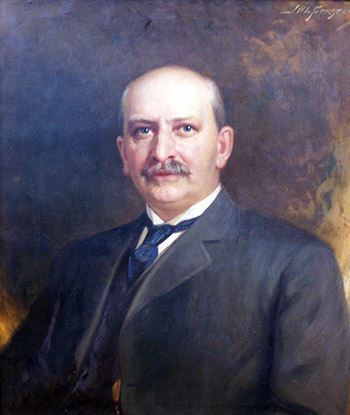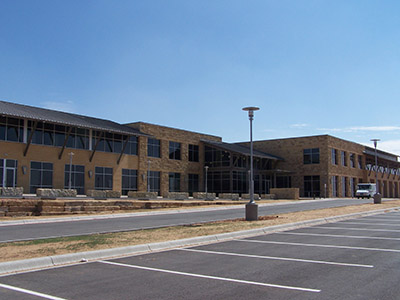By Paul Wiseman

Toronto lawyer, entrepreneur and philanthropist David Fasken, shown in this undated portrait, bought 220,000 acres of west Texas land that he did not see until years later. Now, after 100 years, the family trust is listed by some as the 25th largest private landowner in the United States.
In the early 1900s west Texas was as empty as a whiskey bottle at closing time, and almost as dry. (Some things haven’t changed). What would possess someone in far-off Toronto, Canada, to buy approximately 220,000 acres of the place, sight-unseen, is still somewhat of a mystery. But that is exactly what lawyer, entrepreneur, and philanthropist David Fasken did in 1913.
Some accounts, including an historical marker on SH 158 near Gardendale, list 1912 as the purchase date, but that may just be when the deal was started. Fasken Oil and Ranch, which is descended from David Fasken’s businesses, has always noted May of 1913 as the purchase time.
The historical marker, recalling Fasken’s Midland and Northwestern Railroad, says Fasken bought the “C” ranch from the estate of Chicago meat packer Nelson Morris.
Fasken was a principal with the Toronto law firm of Beatty, Chadwick, and Blackstock. He also had mining interests and power generation investments and was president of an insurance company when he died in 1929.
His original plan was to subdivide the acreage and sell it as farm plots, according to Fasken Oil and Ranch General Manager Norbert Dickman. “Where he got that idea, we’re not sure,” Dickman said with a laugh, acknowledging what West Texans know, that “water was the problem.”
The Midland and Northwestern Railroad was part of that dream. Put into service on January 16, 1916, it was to provide a way to transport people, cattle, and farm products to the Texas and Pacific Railway in Midland from the town of Fasken. Fasken was located on what is now FM 1788, or Telephone Pole Road, at the north end of the C ranch property near Seminole. Andrews and a town called Florey were also along the route. The town at one time had a “one-story depot, hotel, general store, [and] two dwelling houses, [as well as a] schoolhouse, and stock pens,” according to the marker.
Because the railroad was using borrowed equipment, including an engine on loan from the T&P, its schedule was irregular at best. To stave off boredom, and, presumably, to take their minds off the possibility of en-route breakdowns, the railroad’s crew would shoot coyotes along the way, the marker states.
Frequent stops were required because the crew had to open and close numerous gates along the way. Midland historian Nancy McKinley collected this information from Lois Patterson, who taught at the one-room schoolhouse, a role which obliged her to ride the train to Fasken on Monday and back to Midland on Friday. When asked by a fellow passenger about the frequent stops, Patterson explained, “It takes a little doing when it’s wire gates.”
After just four years in business, the railroad went into receivership and was sold to the T & P “after flash floods floated crossties away from (the) roadbed.” So the climate was either too dry or too wet depending on what day it was. The line was abandoned entirely in 1923 due to poor business prospects and what had turned out to be a bad location.
Fortunately for his descendants and the current workforce of 200 people, David Fasken was not deterred by this early defeat. Today, Fasken Oil and Ranch still owns 160,000 acres of the C ranch after selling 90 sections to the Mabee family in the 1930s, but it owns a total of more than 300,000 acres in the Permian Basin and in southwest Texas near Laredo. According to the website www.landreport.com, this makes Fasken the 25th largest private landowner in the United States. The company’s land produces oil and cattle, and now has sprouted an office building, and soon will sport homes, retail, and a 9-hole addition to Green Tree Country Club’s golf course. This is all because David Fasken never gave up on a seemingly desolate and unproductive land.
Fasken’s nephew, Andrew, had managed the railroad. His next task was to run the family’s own cattle business, which he did until his uncle’s passing in 1929. “Shortly after 1929 Andrew Fasken and the trustees of David Fasken’s estate decided to go separate ways,” said Dickman. At that point Andrew began setting up his own businesses in the area, separate from the estate.
Andrew’s son Murray was a noted banker in the area for many years. Some recall Murray noting that his father had parted company with David because Andrew disagreed with the sale of the 90 sections.
David’s son Robert took the helm of the trust, but outlived his father by only a few years, dying in the 1930s. From there it passed to Robert’s children David Fasken, Jr., and Inez A.A. Fasken, who was half-sister to the younger David. The trust’s name was Midland Farms.
Following the pattern, Inez died at a young age in the 1940s while she was living in California. Because Inez had no will, that state’s laws mandated that half her estate pass to her mother, Inez G. Fasken, and the other half to David. At that point, Inez owned 25 percent and David owned 75 percent of the company.
Because son and mother-in-law were very close, this caused no problems. Inez G. Fasken lived into the late 1960s, still holding her 25 percent share. After her death, David inherited the rest of the assets.
 Here the family tree gets some branches grafted in. David, around 1970, married Barbara, who had two sons by a previous marriage. David and Barbara remained together until his death in December of 1982, at which point Barbara inherited everything. She lived until December of 1995.
Here the family tree gets some branches grafted in. David, around 1970, married Barbara, who had two sons by a previous marriage. David and Barbara remained together until his death in December of 1982, at which point Barbara inherited everything. She lived until December of 1995.
Before Barbara died, she set up a family limited partnership called Fasken LTD, which is the entity that owns Fasken Oil and Ranch today.
On the business side of the story, the family’s first foray into oil and gas came in the early 1940s when they leased land to Stanolind Oil. In 1943 Stanolind made the first oil discovery in the Midland Farms field. They also made a shrewd business decision in the leasing.
Rather than simply lease everything to Stanolind, Fasken leased three-fourths of a section and kept the other fourth, meaning the family itself could develop that part. When the Texas Railroad Commission unitized the lease for secondary recovery in the late 1950s or early 60s, it meant the family had a working interest in even the other three-fourths.
Dickman said the story goes that oil was discovered on the land sold to the Mabees before Stanolind made its first Fasken discovery, causing some family distress for a few years, as some thought they had sold off “the family jewels,” in Dickman’s words.
Even before that unitization, David Fasken, Jr., had started reinvesting the Midland Farms revenues into his own drilling projects. Company records show Fasken drilled his first independent well in 1953. He continued through his lifetime, and Barbara kept it up after David’s death, drilling approximately one well a month.
Some wells were on Fasken property, but Dickman said he also became active in Southeast New Mexico Morrow gas play in the Delaware Basin.
While Fasken was the visionary, he seemingly had little patience for the day-to-day operations, hiring people under him who hired people under them. Attorney Richard S. Brooks ran the business in general, but he himself did not handle the oil and gas part. Brooks hired two engineering companies to work 100 percent for Fasken. One of them was run by a Jim Henry (not the Jim Henry known in the Permian Basin today). Brooks also hired a geophysical firm, run by Bill Humbard, to do the same thing.
Also farmed out was all the accounting, handled by Louis Bartha. Louis Bartha’s son, Dr. Gregory Bartha, was a noted physician in Midland for many years. Finally, Bob Leonard did the geologist work for Fasken.
Dickman himself came aboard this way, doing some legal work for the company while living in San Francisco in 1973.
Upon David’s death in 1982, his widow, Barbara, decided to take a more active role in the company. Over a period of time she turned the consultants into direct employees of Fasken. By 1988, everyone was a direct employee, a procedure that Dickman and a man named Ben Blake helped put together. At that time, Barbara asked Dickman to move to Texas to become the general manager.
After Barbara’s passing in 1995, the company continued the drilling of one or so wells per month until the discovery of the Wolfberry play. “We found that that play was very prolific under Midland Farms so we started increasing our drilling.” At the start of this era, the company had 50 employees, growing to its current 200 count in the 17 years since her passing. They have moved up from the 12-20 wells per year pace that reigned for decades to the point that the company will drill 140 wells in 2013. Although most of that is in the Wolfberry, there is still activity in Southeast New Mexico and, additionally, in Webb County’s portion of the Eagle Ford shale.
Oil and gas continue to be the lion’s share of the Fasken Oil and Ranch business, but real estate has begun to take a bigger role. In 1957 David, Jr., made a purchase that would impact both the oil business and real estate. He purchased two ranches and a farm in Webb County—taking the farm only because the seller insisted that it be included.
Fast forward about three decades and the city of Laredo, located in Webb County, wanted to build a new bridge across the Rio Grande, connected to I-35. The access road to that proposed bridge crossed the previously unwanted farm. Seeing an opportunity to take advantage of the sudden influx of traffic when the bridge opened in 2000, the company built a number of warehouses on their property. They now have seven warehouses totaling over one million square feet. Single family lots and apartment buildings are also in progress, along with the drilling activity.
Back home in Midland, it’s much the same. Fasken’s new office building, on their own land on Holiday Hill Road close to the Tom and Nadine Craddick Reliever Route of SH 349, is just the start here. The 1,000-acre development will soon include residences, apartment buildings, and retail. They have also worked with Green Tree Country Club on the aforementioned 9-hole addition to the golf course.
The residential development will take shape around existing pumpjacks in a field where the company says it has finished drilling. This is an experiment to see if residences can coexist with pumpjacks over the long haul. Several company executives trekked to California to see how it’s done there and came back with those ideas and some of their own.
There are still Faskens involved with the trust for which Dickman is the general manager, and the company expects to continue unabated for the foreseeable future. Will it last another 100 years? Probably no one alive now will know, but even if it does not, the elder David Fasken’s vision will be felt for generations to come.










